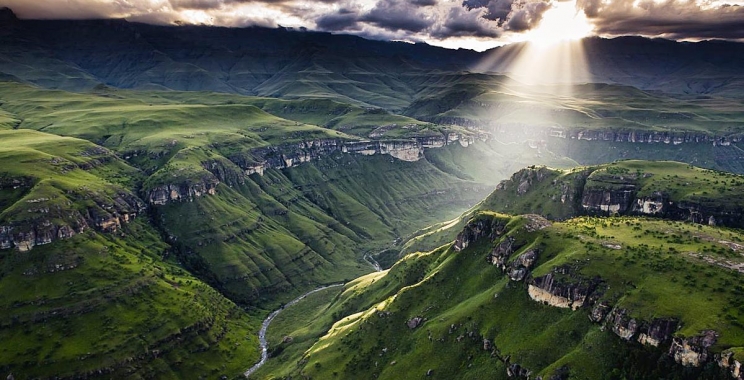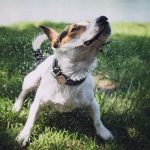Drakensberg Mountains South Africa
Top Things to Do in the Drakensberg

Hot air balloon above Blyde River Canyon
Drive a four-wheel drive over the Sani Pass into Lesotho
Climb chain ladders to the Amphitheatre Summit
Take a hike to the world’s second highest waterfall, Tugela Falls
Admire San rock art all over Maloti-Drakensberg Park
Go hiking in Royal Natal National Park
Search for wildlife close to God’s Window and the Three Rondavels
Inhale the silence of a wonderfully remote South African destination
The Magic of the Drakensberg

The name comes from early Dutch settlers and the Afrikaans language. Drakensbergen translates as “Mountain of Dragons” in reference to sharp peaks and the mountain range’s incredible size.
To the Zulu these mountains are known as uKhahlamba, “the barrier of spears.” The Sotho people of Lesotho use the name Maluti, which has a similar meaning.
The earliest inhabitants were nomadic San bushmen. Their culture and history has been recorded in tens of thousands of rock painting, which are located in caves and caverns across the mountains.
For visitors, the Drakensberg magic comes from all the incredible things to see and do.
Where is the Drakensberg?

The Drakensberg is the southeastern section of the Great Escarpment, or Great Rift Valley, that stretches south to north through most of Africa.
This magnificent mountain range surges over 3000 metres above the plains of South Africa. It creates a natural barrier between South Africa and Lesotho, with some of the peaks showcasing 2000-metre vertical slopes.
While the mountain range extends for over 1000 kilometres towards South Africa’s border with Zimbabwe, visits to the Drakensberg are focused on four key destinations.
These destinations are explained here from south to north.
Southern Drakensberg Visitor Guide

Southern Drakensberg is a wilderness area bordering South Africa and Lesotho. The closest South African town is Underberg and the whole area is part of Maloti-Drakensberg Park.
Underberg is 2 ½ hours by road from Durban and King Shaka International Airport. It is a six-hour drive from Johannesburg. When driving from Durban to Cape Town you can hug the coast, or travel inland to stop at the Drakensberg.
The Sani Pass

This is an enormous wilderness, with innumerable opportunities to go hiking, bird watching, trout fishing and horse riding. However, there is one world-famous attraction – the Sani Pass.
This incredible mountain pass is the highest and most dramatic road anywhere in Southern Africa. It zigzags between Underberg and Lesotho and is a very challenging route in a four-wheel drive vehicle. Never attempt to cross the Sani Pass in bad weather and don’t even set off without a four-wheel drive.
The road starts at 1544 metres and rises to 2876 metres above sea level. Some sections are as steep as a 33% gradient! The highest sections are made of gravel! South African authorities won’t even let you onto the road without a suitable vehicle.
You will need your passport as the top of the pass is located in Lesotho.
Car wrecks litter the ravines. Mud and ice can be encountered at all months of the year. Get to the summit and you can have a drink at the highest pub in Africa, while gazing down upon the incredible road. Watch out because the altitude may get to your head more than the alcohol!

Once in Lesotho you can visit a couple of small villages and get a sense of this kingdom in the sky. There is accommodation near the summit of the pass if you want to stay the night.
Other Things to Do in Southern Drakensberg

Another highlight of Southern Drakensberg is the rock art. Local guides can show you dozens of rock art sights. Most of these can only be visited on foot or by horseback.
The entire Drakensberg-Maluti area is a World Heritage Site due to the abundance of rock art. Estimates put the number of paintings at 35,000-40,000. However, more paintings are constantly being discovered.
South Africans also visit the Southern Drakensberg for some of the world’s best trout fishing. You will need a good guide to access the best spots.
Anyone with an adventurous spirit can set off on some of the region’s hiking trails. These are usually empty as most hikers visit the Northern Drakensberg instead.
Where to Stay
Small lodges are dotted around the region. Some are located in the town of Underberg, others are situated on lower sections of the Sani Pass.
This entire area is incredibly remote. There are very few shops, restaurants, cafes or bars. Most visitors eat at their accommodation. You can also find campsites and Southern Drakensberg is a wonderful place if you are fully self-sufficient.
Northern Drakensberg Visitor Guide

Confusingly, the Northern Drakensberg is not in the north of the Drakensberg. It is just further north than the Southern Drakensberg!
Northern Drakensberg is the most popular Drakensberg destination and incorporates the northern section of Maloti-Drakensberg Park, Giants Castle Game Reserve, Royal Natal National Park and Golden Gate Highlands National Park.
To add to any confusion, this area is also known as uKhahlamba Drakensberg Park. It is a landscape of enormous peaks, sandstone cliffs, hidden valleys and ancient rock art.
This area is more accessible than Southern Drakensberg as it is roughly halfway between Durban and Johannesburg. The mountains are practically on route to Durban, just 30 minutes off the N3 highway.
Where to Stay

Accommodation is dotted all around the region, including backpacker hostels, lodges, small guesthouses, and campsites.
Like the Southern Drakensberg there is no real town with a concentration of restaurants and bars. Instead, you will find the odd restaurant or farm cafe along the road.
The area around Bergville has the most accommodation, but it’s worth spreading your search as there are good guesthouses across the region. Wherever you stay, stock up on supplies in Bergville or Harrismith as there are very few shops elsewhere.
Also take note of campgrounds inside the national park, such as the excellent Mahai Campsite. Facilities are simple and clean. Some have electricity points.
Amphitheatre Summit and Tugela Falls

One of the world’s ultimate day hikes, a walk to Tugela Falls climbs over 1000 metres in altitude. Amphitheatre is like a giant version of Table Mountain and has a vertical front face that initially appears impossible to climb.
You can only reach the summit via a contour path and chain ladders. This is a challenging hike but like Table Mountain, it is feasible for most visitors, as long as you have an experienced mountain guide. The flat mountain summit is shaped like a horse shoe, hence the name Amphitheatre.
It is highly recommended to go with a guide because the trail is not always clear. Plus, get too close to the edge and it’s a fear-inducing 1000-metre straight drop.

This scenic hike first ascends to the Amphitheatre summit. Then you keep walking for another hour across the summit to reach Tugela Falls.
At 948 metres Tugela is the world’s second highest waterfall and starts at more than 3000 metres above sea level. You can stand at the top of the waterfall and look down. Guides know a few nearby viewpoints where you can gaze across at the falls.
Royal Natal National Park

This small national park is a haven for hikers and also contains great rock art.
Tugela Gorge (not Tugela Falls) is a tough hike and involves jumping across rocks as you travel up the river gorge. The Cascades is a much easier hike and more suitable for families, or anyone with sore legs after a day on the Amphitheatre.
Dedicated rock art trails are another option in this national park. You need a good guide because there are so many stories behind the art, plus, most of the best art is hidden in caves and not signposted.
Painting tell of wandering antelope, successful hunts, births, deaths and other important events in a community.
Much of the art was painted as messages to other nomadic San people, so they warn of nearby leopard and even the arrival or warring armies.
Mountain bike trails

A 100 km mountain track crosses through Maloti-Drakensberg park and can be covered over one or multiple days. You will need a pass from All Out Adventures and this can be arranged through your accommodation.
With stunning views and countless bridges, this trail is one of the biking highlights of Africa. Its most spectacular highlight is the Grotto Trail, a 25 km loop that is geared towards experienced mountain bikers.
Other sections of the trail are suitable for beginner and intermediate riders.
Giant’s Castle

Giant’s Castle isn’t a major safari destination but you can find a nice selection of antelope and birdlife here, including bearded vultures and springbok.
Like elsewhere in the uKhahlamba Drakensberg area it can also be visited for exceptional hiking trails and rock art.
Other things to do in Northern Drakensberg
All Out Adventures also offer activities like a suspension bridge swing, 900 metres of zip lining, and quad biking.
Another highlight is to do nothing. Just to gaze out at the Amphitheatre Mountains is a wonderful experience and the entire Drakensberg is a place to connect with your wild side.
Lesotho

Travel to the top of the Drakensberg and you will reach Lesotho. The Sotho people ascended these mountains then defended their mountaintop territory from above, mostly by throwing spears at any Zulu coming up the passes (hence uKhahlamba, “the barrier of spears”).
Lesotho is a wonderful little place where the culture is completely different to anywhere else. Most men work as shepherds. They start around age 10 and get paid a sheep for every month they work.
By the age of 30 they have enough sheep to retire. So they pay lobola (bride price), take a young bride and start a family.
There are parts of Lesotho that the Internet is yet to penetrate. It is an incredibly remote nation that has preserved its culture and continues to do so, mainly because of its isolated location.

Visit Northern or Southern Drakensberg and you can arrange a day or overnight trip into Lesotho. You can enter the country via the Sani Pass in a four-wheel drive. It is easier to drive to Lesotho from the Northern Drakensberg as the mountain pass is fully sealed, rather than a gravel road.
One Lesotho highlight is to ride a horse across the country. Sotho people love their horses and with so much wilderness you can gallop towards the horizon.
Small camps and traditional homestays can be found across the country. Note that facilities are basic but you can expect a very warm welcome.
Mpumalanga Drakensberg
The Drakensberg range winds north from the Amphitheatre. From this dramatically flat summit it dips and falls, turning into a rolling escarpment that crosses KwaZulu-Natal province.
As it winds north into Mpumalanga province it forms three spectacular natural attractions. These are located around 50 km west of Kruger National Park and are commonly visited as part of a Kruger safari.
All these attractions are located in Blyde River Canyon Nature Reserve and can be visited in the same day. Like Northern and Southern Drakensberg, they feature dramatic high mountains and rugged geological formations. They are landscapes that take the breath away, landscape you will remember for many years to come.
Blyde River Canyon Nature Reserve (Motlatse Canyon)

At 25 km long and over 1 km in height, Blyde River Canyon is second only in size to Fish River Canyon in Africa.
Thick bush covers the narrow canyon in a carpet of green. This is topped by red sandstone peaks and vertical walls. Lush subtropical foliage and precipitous cliffs create a scene that’s unrivalled anywhere on the planet.
The famous Blyde River Canyon view is of the Three Rondavels, enormous circular rocks that look like the home of native giants.
God’s Window is further along the canyon. From here you can gaze across a length of 700 metre vertical cliffs and can see all the way into Kruger National Park.

These natural attractions are part of the Panorama Route. From Graskop this route winds alongside the canyon, Three Rondavels, Bourke’s Luck Potholes, God’s Window and the Pinnacle.
You can hot air balloon above the canyon if the wind is blowing west from the Kruger. Otherwise a hot air balloon ride will take you eastwards, above herds of wild animals.
Tours to Kruger National Park usually stop at Blyde River Canyon on the first or last day, i.e. on the way to or from safari. Many Sabi Sands reserves organise half-day trips to the canyon.
Although everyone follows the same route, it is rarely crowded here other than during the peak Christmas season. For more information about when to go see our South Africa safari guide.
Planning a Drakensberg Vacation

Getting Around the Drakensberg
The Drakensberg is not a very accessible destination for visitors traveling on public transport. There are no towns or cities, nor any scheduled bus services to the destinations.
This is a destination where it really pays to have your own transport. Individual attractions are well spaced out and cannot be reached without your own transport or a guided tour.
The Baz Bus is a hop-on hop-off service dropping passengers at accommodation in Northern and Southern Drakensberg, including the superb Amphitheatre Backpackers. Guided tours to places like Tugela Falls can be arranged after you arrive.
Another option is a fully guided tour through South Africa. Many tour itineraries spend two to three days in the Drakensberg, but you can easily stay longer with a personalised tour.
Blyde River Canyon can be visited independently if you have a vehicle. It is also a popular day trip when on a safari in the Sabi Sands or Kruger National Park.
A popular one-week itinerary involves three days in uKhahlamba Drakensberg then three days in the Greater Kruger. This can start and end in Johannesburg and Africa’s largest airport.
Give Yourself Enough Time

There are some places you can visit in a day and see everything. Then there are places like the Drakensberg, where you can spend a year and not see all there is to offer.
Love Wildlife South Africa With Us!
Tags: Ads, Classified, ClassiadsproLeave a Comment
You must be logged in to post a comment.








https://waterfallmagazine.com
Sweet blog! I found it while surfing around on Yahoo
News. Do you have any tips on how to get listed in Yahoo News?
I’ve been trying for a while but I never seem to get there!
Thank you